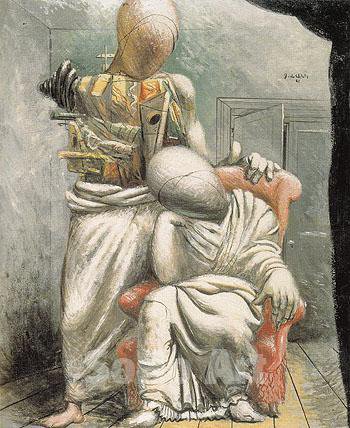The Surrealists
dal 30/10/2013 al 1/3/2013
Segnalato da
30/10/2013
The Surrealists
Philadelphia Museum of Art Perelman Building, Philadelphia
Works from the Collection. Surveying the period during which Surrealism flourished - from the mid-1920s to the late 1940s in Europe and the United States - this exhibition will begin by examining the movement's Parisian origins and trace its development over time as its methods and goals were embraced by a broad international avant-garde.

The Surrealists: Works from the Collection will provide a selection of exceptional works from the Philadelphia Museum of Art that represent one of the most influential art movements of the twentieth century. Surveying the period during which Surrealism flourished—from the mid-1920s to the late 1940s in Europe and the United States—this exhibition will begin by examining the movement’s Parisian origins and trace its development over time as its methods and goals were embraced by a broad international avant-garde. Reflecting a deep fascination with psychoanalysis and dreams as well as myth and fantasy, the work of the Surrealists explored the use of chance and spontaneity to access the unconscious, defined new ways of making art, and tested the boundaries of social acceptability.
The artists of the Surrealist movement experimented with a variety of approaches to obtain unexpected results by tapping into the subconscious mind. This is seen in Animal Caught in a Trap (1929), where André Masson used automatic drawing as a starting point for the development of an abstracted image. Joan Miró broke with established forms of painting by experimenting with collage, assemblage, the unlikely juxtaposition of images, and simplified forms and bold colors, as in Dog Barking at the Moon (1926). Jean Arp used torn and scattered ink in a series of drawings, each called Composition (1937), to play with the idea of chance as the foundation for a new aesthetic approach.
During the 1930s, Surrealism emerged as major force on the international scene and developed a political voice in the years leading up to the Spanish Civil War and World War II. Miró’s Person in the Presence of Nature (1935) suggests the mounting pressures within the artist’s home country, while Salvador Dalí’s Soft Construction with Boiled Beans (Premonition of Civil War), painted a year later, foreshadowed the horror of the conflicts to come. These fantastical scenes were the result of attempts to access the unconscious through psychoanalysis and the study of dreams, while providing commentary on real world tragedies.
With Europeans taking refuge in the United States during World War II, the center of the Surrealist movement shifted to New York. Julien Levy was one of the many art dealers who introduced Surrealism to collectors and new audiences in this country. The work of many of the artists he represented will be included in this exhibition, including photographs by Man Ray and Lee Miller. Max Ernst, a pioneer of Surrealism, was one of many European exiles who made a new life for themselves here, eventually marrying fellow artist Dorothea Tanning. Her masterpiece Birthday (1942) is an iconic self-portrait in an empty room with doors leading into an infinite recession of space. A similar confounding of reason is reflected in Kay Sage’s defined dreamscapes, such as Unicorns Came Down to the Sea (1948). The Surrealists’ fascination with automatic drawing evolved to take new forms over time, as reflected in the evocative space and crystalline shapes of Matta’s painting The Bachelors Twenty Years Later (1943), the title of which refers to Marcel Duchamp’s The Large Glass.
The exhibition will end with works from the International Surrealist Exhibition at the Galérie Maeght, Paris (1947), the first major showing of Surrealism in Europe after World War II. This section includes the work of Enrico Donati, one of the movement’s younger artists. His sculpture The Evil Eye (1947) is a recent acquisition. Set in acrylic glass, the eye’s copper wire roots are visible beneath the platform that is backed by a monkey head visible only in a series of mirrors mimicking the waxing and waning moon.
This exhibition contains more than seventy works from the collection by over forty artists. Important publications and documentary materials, including photographs of the Surrealists at work or leisure, exhibition catalogues, and the periodicals Minotaure, VVV, and View, are also included in the exhibition. Excerpts of the Surrealist manifestos will be broadcast in the gallery, offering visitors a multisensory experience of the movement, its ambitions, and its unique history.
On Friday, November 8, the Perelman Building will be open from 6:00–9:00 p.m. for an evening celebration for the exhibition The Surrealists, including a cash bar and live music from DJs Broadzilla and Anthony Campuzano. Admission is free but RSVP is required at http://www.eventbrite.com/event/7807762227/3.
Image: Giorgio de Chirico, The Poet and His Muse, c. 1925. Oil and tempera on canvas, 35 7/8 x 29 inches (91.1 x 73.7 cm). Philadelphia Museum of Art, The Louise and Walter Arensberg Collection, 1950. © Artists Rights Society (ARS), New York / SIAE, Rome
Press Officer: Kristina Garcia Wade 215-684-7860 kristina.garcia@philamuseum.org
Communications Department: (215) 684-7860, by fax at (215) 235-0050, or by e-mail at pressroom@philamuseum.org
Press Preview October 31, 2013 at 9:00 a.m.
Remarks at 10:00 a.m., followed by a curator-led tour.
Philadelphia Museum of Art Perelman Building
Pennsylvania Avenue at 26th Street Philadelphia
Tuesday and Thursday through Sunday: 10:00 a.m.–5:00 p.m., Wednesday: 10:00 a.m.–8:45 p.m. The exhibition will be closed on Thanksgiving Day and Christmas Day and open during normal hours on New Year’s Day, Martin Luther King Jr. Day, and Presidents’ Day.



